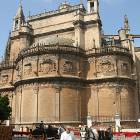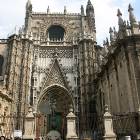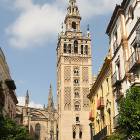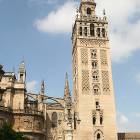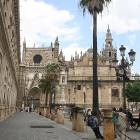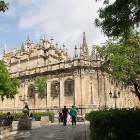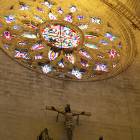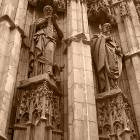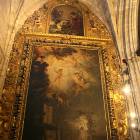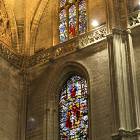The greatest Gothic cathedral in the world, the place where Christopher Columbus rests
Religious architecture is not only indicative of a community’s spiritual fervor, but also of its economical and technological status. For a thousand years, after the decay of Rome, Constantinople was the religious and economical capital of the world. And Hagia Sophia remained the largest religious building on the face of the Earth. Than even the mighty walls of Constantinople have fallen to the canons of the emerging Ottoman Empire. The Bosphorus, the straight that connected Europe and Asia, and the major sea routes became a dangerous point, so the West was pressed to find another way of getting the marvelous hand-made goods, the spices and other resources from India and China. Thus the age of bold explorers began: instead of going East and along the shores of the Mediterranean as they always did, they ventured West and into the unknown. Bartolomeu Dias, Christopher Columbus, Vasco da Gama, Ferdinand Magellan discovered not only new routes, but also new continents and islands, opening an age of bounty for those empire that sponsored their quest and a dramatic time for the populations of the New World. It was the beginning of colonialism.
It comes as no surprise that the Spanish empire, which financed the most successful of these missions, which lead to the discovery of America, was the first to surpass in greatness the architecture of old Bizantium. The cathedral of Seville was the first to be larger than Hagia Sophia and is to this day the largest Gothic cathedral in the world. But Seville’s Cathedral was finished a long time before the empire took intercontinental dimensions. The first step before spreading its possessions on 5 continents was for Spain to regain ‘its’ Iberian Peninsula from the Moors that held it for about seven centuries. That long process of reconquering was called Reconquista. Spiritually, this cathedral is dedicated to Our Lady (Santa Maria), but politically, it celebrates the success of regaining Iberia from the Muslim rulership and anounces the great ambitions of the empire that was to come.
Catedral de Santa Maria de la Sede had a similar fate with Hagia Sophia: due to builders’ ambitions running over the technological capabilities of its time, the dome of both churches collapsed shortly after the inauguration and had to be remade. At Seville, it happened twice to the cathedral started in 1402. As for the usage of this groundbreaking building, it had a completely opposite destiny to the one in Constantinople. If Hagia Sophia was turned into a mosque later on, Seville’s Cathedral used some elements from a previous mosque existing on its place.
It would be impossible to tell that by the Gothic style that’s evident allover the place, with its impressive web of ribbed vaults. But looking closer, the exuberance of Islamic art is everywhere in the meticulous decorations of the ceiling. It’s even in the most treasured element, the golden altarpiece which took Pierre Dancart an entire life to complete. In 44 years, Dancart sculpted numerous Biblical scenes in what was to become the largest altarpiece in the world. The decorations are excessive and the amount of gold used makes these scenes unclear, despite the painted statues included in each scene.
The architects of this grandiose monument were Alonso Martinez, Pierre Dancart, Carles Galtes de Ruan and Alonso Rodriguez. It is 42 m high on the inside, but right next to it there is a former 12th century minaret, turned into a bell tower, that is 105 m. Known as Giralda, this square based tower is the most recognizable building in Seville. Right next to it there is a beautiful gate decorated with rows of bass reliefs depicting the Adoration of the Magi, a theme that was recurrent many centuries later in Sagrada Familia.
Christopher Columbus is buried here, next to three kings and one queen. Surprisingly, the navigator has the most spectacular tomb of them all. Columbus died in Valladolid, but his remains took a bizarre road across the Ocean, going to a monastery in Seville, his first established colony in Santo Domingo the Dominican Republic, than to Havana Cuba, and finally, here, in Seville’s Cathedral. It was a macabre journey of almost 400 years, marked by wars, annexations and political ambitions. As one that was a traveler his entire life, the Genovese did not return to his Italian hometown, and the way his coffin is in the air, on the shoulders of four marching men creates the unusual impression of perpetual motion toward the unknown. The four male figures sculpted to support the coffin represent the historic kingdoms of Spain: Aragon, Castille, Navarra and Leon.
- Home Page
start page - Architecture
landmark buildings - Sacred architecture
places of worship - Nature
landscape photography - Concert
performing artists - Christmas
Santa Claus pictures
- Jooble
jobs for photographers - Escape
an out of control blog - Merry Christmas
The best organizer of Christmas parties - Astro photo
Eclipse hunting and astrological photography





